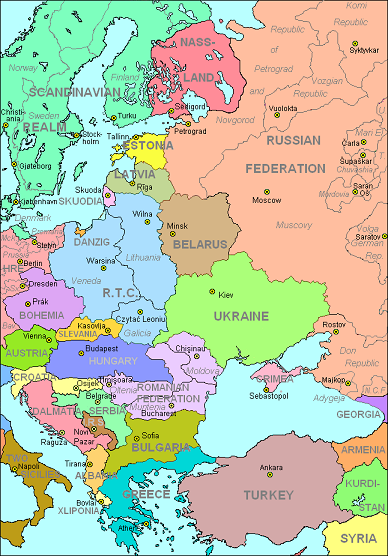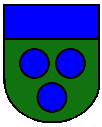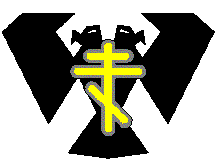 Ill Bethisad is a constructed universe. Or rather, our universe but with an
alternate history. Originally, it was designed by Andrew Smith as a universe in which Wales and surroundings
speak a Romance language, Brithenig. However,
with the years others have joined the project, and currently Ill Bethisad is the common effort of over seventy
participants, each of whom has his own personal style of (re)writing history, (re)drawing maps and the like.
This alternate history is not extremely different from ours, but contains a lot of “what ifs”,
including a number of constructed languages. All there is to know about Ill Bethisad, you can find on its
home page. Other interesting pages to check out are
Flags of Ill Bethisad and the
IB Wiki.
Ill Bethisad is a constructed universe. Or rather, our universe but with an
alternate history. Originally, it was designed by Andrew Smith as a universe in which Wales and surroundings
speak a Romance language, Brithenig. However,
with the years others have joined the project, and currently Ill Bethisad is the common effort of over seventy
participants, each of whom has his own personal style of (re)writing history, (re)drawing maps and the like.
This alternate history is not extremely different from ours, but contains a lot of “what ifs”,
including a number of constructed languages. All there is to know about Ill Bethisad, you can find on its
home page. Other interesting pages to check out are
Flags of Ill Bethisad and the
IB Wiki.
These pages are dedicated to Eastern Europe in Ill Bethisad. Click
here for an actual and a few historical maps of the region. Below follows
a complete list of Eastern European countries. Very immodestly, I will begin with my own stuff.
Russia
Like in our own world, the largest country in the region is the Russian
Federation. Its history has not been significantly different until the Russian Revolution, but after that
things change: the Bolsheviks are beaten by the White Armies in 1918, who then establish a Russian-nationalist
dictatorship. After the fall of the regime, Russia becomes a loose federation of 29 republics. You can see them
on this map.
One of those republics that has been developed in particular is the Vozgian Republic.
Its language is a North-Slavic language called Vozgian. For info about the other republics, click
here.
Republic of the Two Crowns
The Republic of the Two Crowns is basically today's continuation of the old
Polish-Lithuanian Commonwealth. There is, however, a significant difference: neither the Polish language nor the
Polish nation exist in Ill Bethisad. Instead, the main language of the Republic is Wenedyk,
a Romance language that went through a similar development from Latin as Polish did from
Common Slavic. Since the Second Great War, the
Republic consists of two kingdoms: Veneda and
Lithuania (the latter being developed not by me, but by
Augustinas "Abdul-Aziz" Žemaitis). Click here for a map.

Highly interconnected with the RTC is the Free City of Danzig.
Bohemia and Slevania
IB's equivalent of the Czech Republic and Slovakia, but their territories are about where the similarity ends.
The Bohemian Kingdom is a bit like Eastern
Europe's Switzerland. The Czech language exists in IB, but has largely been pushed aside by a Germanic-Czech hybrid
language called Pémiš (Bohemian).
Both were created by Jan Havliš.
Slevania is the counterpart of what Slovakia is in our
world. There is no such thing as a Slovak language in IB. Instead, there is Slvanjek,
a Romance language closely related to Wenedyk. Both languages were developed in close
collaboration. Thank you, Benct Philip Jonsson, for that!
Hungary and Romania
Hungary is not significantly different from Hungary in
our timeline. Romania on the other hand is. The Romanian Federation
has been in existence only since 1990. Before that, Romania was the territory of three independent states with quite
different histories, Oltenia, Muntenia and Moldova.
The Balkans
The most powerful of country of the Balkan Peninsula (and one of the oldest countries developed within the context of IB,
I should add), is undoubtedly Dalmatia. Whereas in our timeline the
Dalmatian language died out over a century ago, the Dalmatian
language in IB is alive and kicking! It was created by Frank George Váloczy. Several maps of Dalmatia and other
parts of the Balkans can be found here.
Another country you won't find in any atlas is the Kingdom of
Xliponia, a small country located between Albania, Greece and the Adriatic Sea, with a long history, an old and rich
culture, and a lot of money. A small paradise, if you ask me! Xliponia speaks a Romance language,
Xliponian. All credits for both the country and
the language should go to Ronald Kyrmse.
The role of Greece during the Second Great War similar to that of Italy *here*.
But even nowadays, it is a dangerous and power-hungry country in the Southeastern corner of Europe. It has been worked on by Nik Taylor
and Konstantinos Leganopoulos. On the territory of Greece, we can find a small mini-state in the form of the
Monastic Republic, located around Mt. Athos and created by Charlie Brickner.
Other Balkan countries, less developed, but still worth a read, are: Albania,
Bulgaria, Croatia,
Sanjak, Serbia,
Slovenia (unwillingly part of Croatia),
and Turkey.
It's not only independent states that have their own website. While you're at it, by all means do pay a visit to Hugo Reed-Gillibrand’s
attractive page on Istria, another country that is not quite willingly part of Croatia.

The Baltic Countries
Most up to the North, in a region that covers more or less *here*'s Eastern Finland and Karelia, is the home of Nassians,
a North-Slavic people speaking a highly interesting language, Nasika,
and inhabinting a state called Nasëku Vesemirü.
Both were created by Jan Havliš.
The other Baltic countries are Estonia,
Latvia, and Skuodia.
The latter is another small country, located between Latvia and Lithuania. Its habitants speak yet another North Slavic language,
Skuodian, which was created by Pavel Iosad.
Remaining countries
For all the countries listed above, except for Russia and perhaps the Baltic countries, the qualification "Eastern
European" is a bit of a misnomer. They would be better off if I had called them "Central European" instead. So, let's
move on to the countries that are really Eastern Europe.
Three countries are located between Russia and the Central European ones: Belarus,
Ukraine, and the Crimea. Countries with a turbulent history!
The Crimea, I could add, is in interesting melting pot of Slavs, Crimean Goths, Crimean Tatars and others.
On the Caucasus, things aren't much different from our timeline, except that Georgia,
Armenia and Azerbaijan generally have a
longer history of independence than they do here.
Two other countries do technically not belong to Europe, but to Asia. I list them here anyway, because they once belonged
to the snorist (eh?) bloc of nations. I'm talking about
Turkestan and Uyguristan. Both countries
are closely related to each other and represent and interesting mix of several different religions. Their histories are thoroughly
intertwined. They have been developed in detail by Geoff Horswood.
Not part of Eastern Europe either, but I need to list it somewhere, is the Holy
Roman Empire, as Germany is still called in IB. Click here for a map.
 Ill Bethisad is a constructed universe. Or rather, our universe but with an
alternate history. Originally, it was designed by Andrew Smith as a universe in which Wales and surroundings
speak a Romance language, Brithenig. However,
with the years others have joined the project, and currently Ill Bethisad is the common effort of over seventy
participants, each of whom has his own personal style of (re)writing history, (re)drawing maps and the like.
This alternate history is not extremely different from ours, but contains a lot of “what ifs”,
including a number of constructed languages. All there is to know about Ill Bethisad, you can find on its
home page. Other interesting pages to check out are
Flags of Ill Bethisad and the
IB Wiki.
Ill Bethisad is a constructed universe. Or rather, our universe but with an
alternate history. Originally, it was designed by Andrew Smith as a universe in which Wales and surroundings
speak a Romance language, Brithenig. However,
with the years others have joined the project, and currently Ill Bethisad is the common effort of over seventy
participants, each of whom has his own personal style of (re)writing history, (re)drawing maps and the like.
This alternate history is not extremely different from ours, but contains a lot of “what ifs”,
including a number of constructed languages. All there is to know about Ill Bethisad, you can find on its
home page. Other interesting pages to check out are
Flags of Ill Bethisad and the
IB Wiki.





